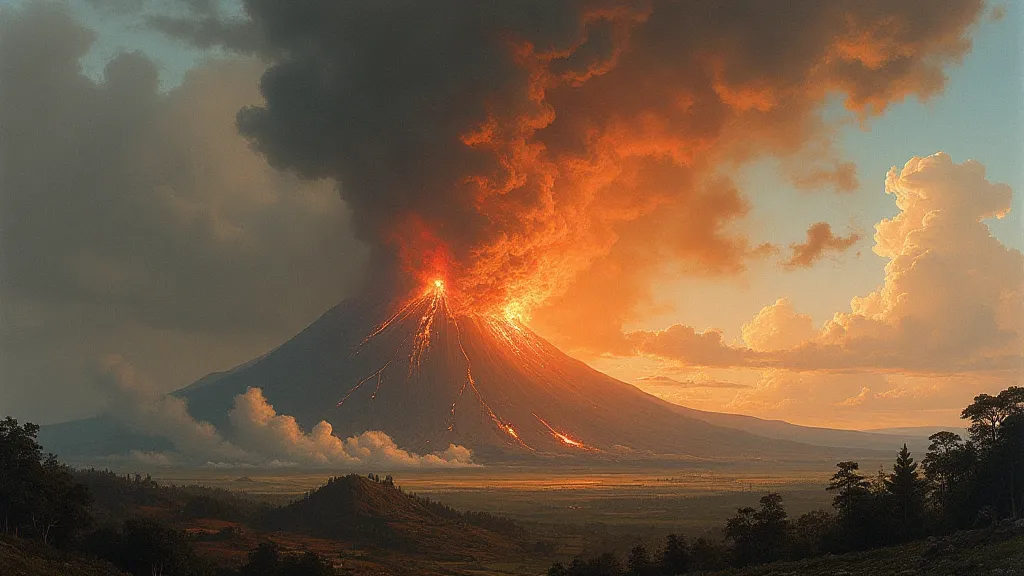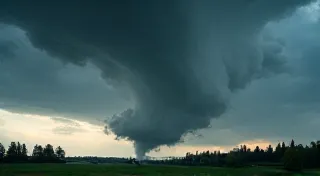The 1816 'Year Without a Summer': Volcanic Impact on Climate
The year 1816 remains one of the most remarkable and unsettling in recorded weather history. Often referred to as the 'Year Without a Summer,' it saw widespread and bizarre climate anomalies across the Northern Hemisphere. While the exact details varied by region, common experiences included unusually cold temperatures, torrential rains, and severely disrupted agricultural cycles. This article delves into the climatic events of 1816 and explores the compelling link to the eruption of Mount Tambora in the Dutch East Indies (modern-day Indonesia).
The Eruption of Mount Tambora – A Global Catastrophe
In April 1815, Mount Tambora erupted with unimaginable force. It was the largest volcanic eruption in recorded history, dwarfing even the Krakatoa eruption of 1883. While the initial eruption devastated the surrounding region, its true impact was to be felt globally over the following year. The immense volume of ash and sulfur dioxide released into the stratosphere spread rapidly around the planet, creating a veil that reflected sunlight back into space. This global disruption highlighted how seemingly localized events can have far-reaching consequences, a phenomenon increasingly understood in the context of modern climate science and patterns of atmospheric disturbance. The sheer scale of the eruption meant it had an influence that rippled outward, profoundly altering weather patterns far beyond its immediate vicinity, echoing events described in detailed accounts of historical fog patterns, which also reveal deep connections between seemingly disparate geographical locations.

Climate Anomalies of 1816 – A Region-by-Region Perspective
The consequences of the Tambora eruption were felt differently depending on location. In North America, the summer of 1816 was marked by persistent cold and heavy rains. New England experienced snow in June and July, and frost occurred repeatedly throughout the summer months. Crop failures were widespread, leading to severe food shortages and economic hardship. The unusually cold weather also impacted daily life, with farmers struggling to harvest what little crops survived and families facing hunger. The unsettling fog and perpetually overcast skies of that season also created an unusual atmospheric condition, a stark contrast to the expected summer weather patterns – a situation that, in modern understanding, shares parallels with observed changing patterns of fog and low clouds across various regions and time periods. The impact wasn't merely agricultural; the constant gloom and unpredictable weather led to a palpable sense of foreboding and uncertainty amongst the populace.
Europe also suffered greatly. The unusually cool summers led to failed harvests across the continent, particularly in Ireland, Scotland, and Germany. Food prices soared, contributing to social unrest and widespread famine. In Switzerland, the cold and darkness led to the phenomenon of “eternal twilight,” influencing artists like J.M.W. Turner, whose paintings captured the eerie atmosphere of the time. The impact of these dramatic environmental shifts wasn’t limited to just the immediate effects on agriculture; they also contributed to a sense of gloom and apprehension that seeped into the cultural consciousness. The disruptions were so profound that they prompted many to reconsider their understanding of the natural world, an intellectual upheaval not unlike the shifts in perception documented by those studying historical sea ice variability – how previously stable conditions could be radically altered, creating unprecedented challenges and opportunities.
Even in regions normally untouched by such extreme weather, the effects were felt. China experienced unusually cool temperatures and torrential rains, and unusual weather patterns disrupted trade routes and agricultural practices across Asia. The unpredictable nature of weather events, even in seemingly stable regions, emphasized the interconnectedness of the Earth's climate system and provides a historical context for analyzing contemporary variations in weather patterns. The disruption of trade routes alone had cascading economic consequences, impacting communities far removed from the direct effects of the volcanic ash.
The Link Between Volcanic Eruptions and Climate: A Historical Lesson
The 'Year Without a Summer' provided a stark illustration of the profound impact volcanic eruptions can have on global climate. While the concept of the “greenhouse effect” was not fully understood at the time, the connection between the eruption and the unusual weather patterns was gradually recognized by some contemporary observers. The dispersal of volcanic aerosols in the stratosphere leads to a temporary cooling effect, reducing the amount of sunlight reaching the Earth's surface. This reduction in sunlight also influenced vegetation patterns, leading to stunted growth and reduced yields, a consequence that echoes in historical accounts of historical wildfires and the ways in which altered weather patterns can impact landscapes. Beyond the immediate impact on agriculture, the atmospheric changes also spurred changes in societal behavior and resource management – a testament to the resilience and adaptability of human communities facing environmental stress.
Impact on Agriculture and Society
The agricultural devastation caused by the 'Year Without a Summer' had far-reaching consequences. Food shortages led to famine and disease, contributing to widespread suffering and social unrest. The economic impacts were significant, with agricultural prices skyrocketing and trade routes disrupted. The crisis also spurred migration, as people sought better living conditions in unaffected regions. The resulting social and economic disruptions caused considerable stress and prompted innovative responses – for example, communities experiencing severe crop failure began experimenting with new cultivation techniques and sourcing food from diverse locations. These adaptations highlight the resilience of human societies in the face of climatic adversity. The psychological toll was immense, and the experience left a deep imprint on the collective memory of the communities affected. The sense of uncertainty and vulnerability underscored the delicate balance between human society and the natural world.

Long-Term Impacts and Lessons for the Future
The 'Year Without a Summer' serves as a powerful reminder of the interconnectedness of our planet's climate system. It demonstrates how events in one region can have global repercussions. Modern climate science has built upon the lessons learned from this historical event, providing a deeper understanding of the role of volcanic aerosols and other factors in shaping Earth's climate. Understanding these historical climate anomalies is crucial as we face the challenges of anthropogenic climate change and strive to mitigate its impacts. Examining past events, such as the conditions that contributed to the atmospheric gloom of 1816, helps us appreciate the complexities involved in managing risks associated with future climate shifts and reinforces the importance of studying the delicate balance of the Earth's climate. The historical record also provides valuable insights into the social and economic consequences of climate variability, reminding us of the importance of building resilience and adaptability in our communities. The crisis forced people to re-evaluate their relationship with the land and to develop new strategies for survival – lessons that remain relevant today.
Furthermore, the psychological impact of these extreme events cannot be overlooked. The persistent darkness and cold significantly affected people's mental well-being, leading to widespread anxiety and despair. Artists and writers of the time captured this sense of gloom in their works, reflecting the pervasive feeling of uncertainty and unease that permeated society. The experience demonstrated that environmental disasters can have profound and lasting effects on human psychology and culture. The artistic and literary responses to the ‘Year Without a Summer’ provide a unique window into the emotional landscape of the time, revealing the profound impact of environmental stress on the human psyche. The atmosphere of uncertainty and dread, immortalized in countless works of art and literature, serves as a stark reminder of the vulnerability of human civilization to the forces of nature. The collective experience of hardship and despair fostered a sense of shared vulnerability and a deep appreciation for the fragility of human existence.
The crisis also spurred innovation in agriculture and food preservation. Faced with widespread crop failures, people experimented with new crops and techniques to increase yields. The crisis also led to advancements in food preservation methods, such as canning and pickling, which helped to extend the shelf life of food and reduce the risk of spoilage. These innovations helped to mitigate the effects of future climate shocks and improve food security. These advancements also showcased the human capacity for ingenuity and resilience in the face of adversity – a testament to the enduring power of human innovation.

Looking forward, the lessons from the 'Year Without a Summer' remain highly relevant. As the world faces the unprecedented challenges of anthropogenic climate change, it is crucial to learn from the past and to develop strategies to mitigate the impacts of future climate shocks. This includes investing in climate-resilient agriculture, developing early warning systems for extreme weather events, and promoting sustainable development practices. By understanding the historical context of climate change and its impact on human societies, we can better prepare for the challenges that lie ahead and build a more resilient future. The echoes of 1816 resonate across centuries, urging us to confront the climate challenges of our time with foresight, determination, and a deep understanding of the interconnectedness of our planet.





